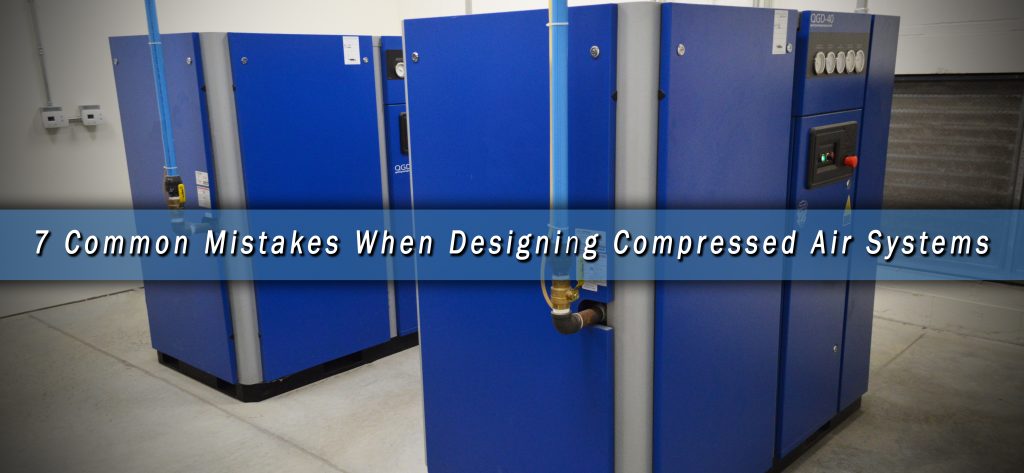April 24, 2018
7 Common Mistakes When Designing Compressed Air Systems
SHARE THIS POST
7 Common Mistakes When Designing Compressed Air Systems
It is vital for your compressed air system to have proper design specifications for overall efficiency and performance. However, many companies do not get the full value of their compressed air system due to basic mistakes in the setup of their system’s design. Thus, they experience costly operating losses that put them at a great disadvantage.
For your compressed air system to work efficiently and achieve optimal performance, while lowering maintenance spend, you should avoid the following common mistakes:
- Incorrect line sizes for airflow piping
A compressed air system with too small piping limits airflow and the overall discharge pressure. It also results in the generation of inadequate compressed air power, therefore, your system will operate at a limited airflow. Further, small piping leads to induced back pressure and increased velocity, as well as turbulence that accelerate the pressure loss. - Sharp angles in compressed air piping
Improper routing with sharp turns leads to loss of pressure. It is essential to route the pipes and union points at 30 or 40-degree directional angles instead of 90 degrees. Using tee joints or other sharp directional angles lead to pressure loss. Ensure that your compressed air system has a smooth and straight pipe routing to keep the air cool and mitigate condensation. - Limited storage
For your compressed air system to work efficiently, it is necessary to have enough storage in your air reservoir. Air reservoir tanks serve as the first stage for moisture separation for the maintenance of compressed air quality. If you have a disproportionate air reservoir for your system, it will not meet storage needs of compressed air or deliver at peak periods when you need more compressed air. You will experience increased compressor cycling, and you might end up with unmet airflow demands during peak periods. - Too small of a compressor
Another common problem companies experience with their compressed air system is when they undersize their system. It results in lower pressure and mechanical failures, especially during peak demand periods. Symptoms of low pressure (or perceived low pressure) can include machinery faults, inability of air cylinders to apply necessary force, or inadequate torque on an air tool. - Not applying recovery systems
If your compressed air system has no heat recovery systems in place, it will be inefficient. If you design your compressed air system to merely exhaust air from the aftercooler, it will result in energy loss. Think about using duct work to direct this “free heat” to warehouses during the cold winter months.
- Failure to accommodate pressure fluctuations
Designing your compressed air system without surge tanks creates insufficient fluctuations, especially when pressure rises at peak periods. - Redundancy
Your compressed air system typically operates critical equipment to keep your plant running. When it goes down, so does your plant! Back up your system and be prepared for maintenance or the unscheduled breakdown!
At C.H. Reed, we understand the importance of a proper compressed air system design. With our specialty in installation, repair and maintenance of compressed air systems, we can help you overcome these 7 common mistakes when designing compressed air systems. Any mistakes in the design of your system can cause a number of inefficiencies and an overall higher operating cost.
With our help, you can achieve significant modifications to your design by adding extra pipes, using a straight layout, small-turn angles for directional joints, and threaded fittings. As a result, you will have an optimized compressed air system design for optimal performance. Contact us today to schedule a complete system analysis.
Search
Categories
Get a consultation
Related Posts
The 3 Distinct Advantages of Hydraulic Powered Pumps
Recently, C. H. Reed helped a major printing operation install a new ink pumping system. The new system needed to transfer four colors of high viscosity, heat-set ink to their three presses, drawing the ink from multiple 5,000…
Simple Ways to Reduce Waste in Your Spray Finishing System
In today’s demanding manufacturing landscape, it can be convenient to adopt a “cut-costs-at-all-costs” mentality, justifying questionable means for the sake of leaner production, a lower bottom line and increased profitability. Regrettably, those efforts can interfere…
What You Need to Know About Air-Powered Pressure Washers
Pressure washers are great solutions for your average cleaning applications, but what tool do you turn to for your more challenging applications? There are many instances where it is simply impossible to use a traditional…
